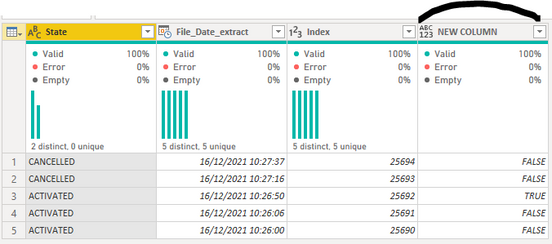- Power BI forums
- Updates
- News & Announcements
- Get Help with Power BI
- Desktop
- Service
- Report Server
- Power Query
- Mobile Apps
- Developer
- DAX Commands and Tips
- Custom Visuals Development Discussion
- Health and Life Sciences
- Power BI Spanish forums
- Translated Spanish Desktop
- Power Platform Integration - Better Together!
- Power Platform Integrations (Read-only)
- Power Platform and Dynamics 365 Integrations (Read-only)
- Training and Consulting
- Instructor Led Training
- Dashboard in a Day for Women, by Women
- Galleries
- Community Connections & How-To Videos
- COVID-19 Data Stories Gallery
- Themes Gallery
- Data Stories Gallery
- R Script Showcase
- Webinars and Video Gallery
- Quick Measures Gallery
- 2021 MSBizAppsSummit Gallery
- 2020 MSBizAppsSummit Gallery
- 2019 MSBizAppsSummit Gallery
- Events
- Ideas
- Custom Visuals Ideas
- Issues
- Issues
- Events
- Upcoming Events
- Community Blog
- Power BI Community Blog
- Custom Visuals Community Blog
- Community Support
- Community Accounts & Registration
- Using the Community
- Community Feedback
Register now to learn Fabric in free live sessions led by the best Microsoft experts. From Apr 16 to May 9, in English and Spanish.
- Power BI forums
- Forums
- Get Help with Power BI
- Power Query
- Re: While Do Loop in Power Query M
- Subscribe to RSS Feed
- Mark Topic as New
- Mark Topic as Read
- Float this Topic for Current User
- Bookmark
- Subscribe
- Printer Friendly Page
- Mark as New
- Bookmark
- Subscribe
- Mute
- Subscribe to RSS Feed
- Permalink
- Report Inappropriate Content
While Do Loop in Power Query M
Hello,
I want to add a new column with as results "True" or "False" using the following data showing in the images.
Each row has a datetime value which is the datetime of the file that has been imported and a state which is CANCELLED or ACTIVATED.
- If the row with the most recent datetime has a state equal to ACTIVATED, then the new column value for that row should be equal to "True" and the rest "False".
- If the row with the most recent datetime has a state equal to CANCELLED, then the new column value for that row should be equal to "False" and the next row with the second most recent datetime where the state is equal to ACTIVATED should be equal to "True" and the rest "False".
- But if the two first rows with the most recent dates are both equal to "CANCELLED", then the third most recent datetime where the state is equal to ACTIVATED should be equal to "True" and the rest "False" and so on...
My guesses are using some sort of a list.generate() or recursive function as it looks like a kind of while do function but maybe there are other solutions.
An idea on how to get my result?
Thank you!
Solved! Go to Solution.
- Mark as New
- Bookmark
- Subscribe
- Mute
- Subscribe to RSS Feed
- Permalink
- Report Inappropriate Content
It looks like you want to tag the first ACTIVATED row. To do this, I'd recommend grouping by [State], taking the min over the date column, filtering [State] = "ACTIVATED", and then merging this back with the step before grouping. Then you can transform the column based on whether or not it's empty.
Here's a sample query you can paste into the Advanced Editor and walk through the steps:
let
Source = Table.FromRows(Json.Document(Binary.Decompress(Binary.FromText("i45Wcnb0c3b18XF1UdJRMtQ31DcyMLQEMZVidVAljfSB0MDIAMQESzo6h3iGOYaAJY31jUGShiAmhqSJvglI0gjEVIqNBQA=", BinaryEncoding.Base64), Compression.Deflate)), let _t = ((type nullable text) meta [Serialized.Text = true]) in type table [State = _t, Date = _t, Index = _t]),
#"Changed Type" = Table.TransformColumnTypes(Source,{{"State", type text}, {"Date", type date}, {"Index", Int64.Type}}),
#"Grouped Rows" = Table.Group(#"Changed Type", {"State"}, {{"MinDate", each List.Min([Date]), type nullable date}}),
#"Filtered Rows" = Table.SelectRows(#"Grouped Rows", each ([State] = "ACTIVATED")),
#"Merged Queries" = Table.NestedJoin(#"Changed Type", {"State", "Date"}, #"Filtered Rows", {"State", "MinDate"}, "New Column", JoinKind.LeftOuter),
#"Transformed Column" = Table.TransformColumns(#"Merged Queries", {{"New Column", each not Table.IsEmpty(_), type logical}})
in
#"Transformed Column"- Mark as New
- Bookmark
- Subscribe
- Mute
- Subscribe to RSS Feed
- Permalink
- Report Inappropriate Content
It looks like you want to tag the first ACTIVATED row. To do this, I'd recommend grouping by [State], taking the min over the date column, filtering [State] = "ACTIVATED", and then merging this back with the step before grouping. Then you can transform the column based on whether or not it's empty.
Here's a sample query you can paste into the Advanced Editor and walk through the steps:
let
Source = Table.FromRows(Json.Document(Binary.Decompress(Binary.FromText("i45Wcnb0c3b18XF1UdJRMtQ31DcyMLQEMZVidVAljfSB0MDIAMQESzo6h3iGOYaAJY31jUGShiAmhqSJvglI0gjEVIqNBQA=", BinaryEncoding.Base64), Compression.Deflate)), let _t = ((type nullable text) meta [Serialized.Text = true]) in type table [State = _t, Date = _t, Index = _t]),
#"Changed Type" = Table.TransformColumnTypes(Source,{{"State", type text}, {"Date", type date}, {"Index", Int64.Type}}),
#"Grouped Rows" = Table.Group(#"Changed Type", {"State"}, {{"MinDate", each List.Min([Date]), type nullable date}}),
#"Filtered Rows" = Table.SelectRows(#"Grouped Rows", each ([State] = "ACTIVATED")),
#"Merged Queries" = Table.NestedJoin(#"Changed Type", {"State", "Date"}, #"Filtered Rows", {"State", "MinDate"}, "New Column", JoinKind.LeftOuter),
#"Transformed Column" = Table.TransformColumns(#"Merged Queries", {{"New Column", each not Table.IsEmpty(_), type logical}})
in
#"Transformed Column"- Mark as New
- Bookmark
- Subscribe
- Mute
- Subscribe to RSS Feed
- Permalink
- Report Inappropriate Content
Thank you very much! This is what I want.
Looks a lot easier than using a List.Generate() and I don't even know if I can get the same result with a List.Generate().
Best regards
- Mark as New
- Bookmark
- Subscribe
- Mute
- Subscribe to RSS Feed
- Permalink
- Report Inappropriate Content
You could do this with List.Accumulate or List.Generate but you don't have to. 🙂
Helpful resources

Microsoft Fabric Learn Together
Covering the world! 9:00-10:30 AM Sydney, 4:00-5:30 PM CET (Paris/Berlin), 7:00-8:30 PM Mexico City

Power BI Monthly Update - April 2024
Check out the April 2024 Power BI update to learn about new features.



